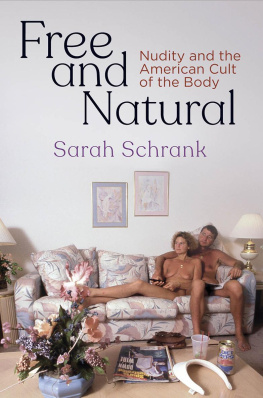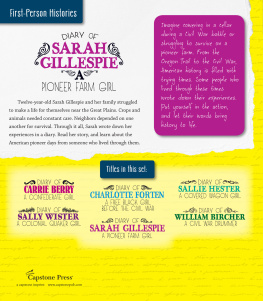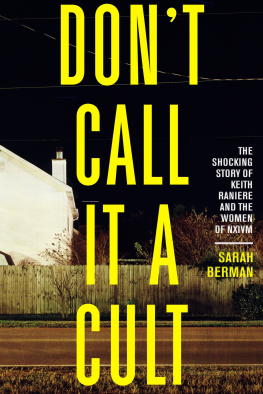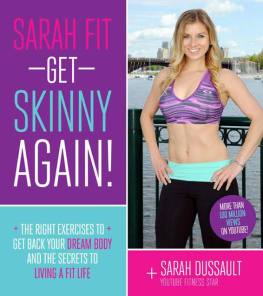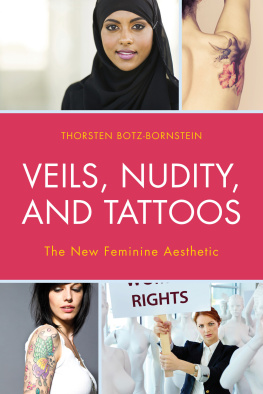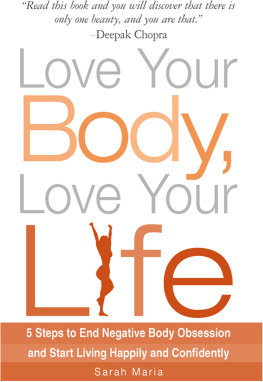Copyright 2019 University of Pennsylvania Press
All rights reserved. Except for brief quotations used for purposes of review or scholarly citation, none of this book may be reproduced in any form by any means without written permission from the publisher.
Published by
University of Pennsylvania Press
Philadelphia, Pennsylvania 19104-4112
www.upenn.edu/pennpress
Printed in the United States of America on acid-free paper
10 9 8 7 6 5 4 3 2 1
Library of Congress Cataloging-in-Publication Data
Names: Schrank, Sarah, author.
Title: Free and natural: nudity and the American cult of the body / Sarah Schrank.
Other titles: Nature and culture in America.
Description: 1st edition. | Philadelphia: University of Pennsylvania Press, [2019] | Series: Nature and culture in America | Includes bibliographical references and index.
Identifiers: LCCN 2018053108 | ISBN 9780812251425 (hardcover)
Subjects: LCSH: NudismUnited StatesHistory. | NuditySocial aspectsUnited StatesHistory. | Human bodySocial aspectsUnited StatesHistory.
Classification: LCC GV450.S325 2019 | DDC 613/.194dc23
LC record available at https://lccn.loc.gov/2018053108
In 1916, the prolific journalist George Wharton James, famous for his colorful accounts of Native American life in the Southwest and florid Southern California boosterism, self-published a memoir entitled Living the Radiant Life: A Personal Narrative. Featuring a swirl of modern Christian thought, praise for Whitmans and Twains portrayals of America, shameless name-dropping, and references to his own Western adventuring, the book is most remarkable for Jamess extolling the body beautiful and his quest for a liberated experience in nature. From his opening line, Everything in Nature is radiant, James explored his theory that if human beings could just marry mind, body, and soul through encounters with nature, we all could achieve longevity and vigorous health.
In prose startlingly reminiscent of todays New Age lingo, James described ideal health as emanating from the body in straight, parallel lines, invisible to everyone but the occultists eye, but experienced personally as charisma, vigor, and joy. The healthy body was a radiant body full of energy and life-force.
The key to the radiant health James held dear was the life lived outdoors, and so he instructed his readers first to emulate the American Indian: Learn of him and be wise. He is a believer in the virtue of the outdoor life, not as an occasional thing, but as his regular, uniform habit. He lives out of doors; and not only does his body remain in the open, but his mind, his soul, are ever also there.
For James, the radiant life of the outdoors trumped the modern industrial urban world which, despite its pleasures in the ballroom, were accompanied by languor the next day, ennui, jealousy, heart-burnings, gossiping, cruel slandering, [and] ruination of health.
For all of Jamess clear directives for achieving a blissful life, his own was marked by conflict and contradiction. A British Methodist minister, James immigrated to the United States in the 1880s with his wife, first settling in Long Beach, California, only to have her sue him for divorce for adultery and to be defrocked by the church for fraud and sexual misconduct. Smeared in the Los Angeles Times for tales of revolting domestic crimes and sexual deviance too filthy to print, James was all but run out of town.
While neither the first nor the only proponent of the modern life lived out-of-doors, James serves as a sublimely articulate advocate of what became the free and natural lifestyle in the United States. In his tastes for nudity, vegetarianism, sexual exploration, primitivism, Southern California leisure culture, mind-body ideology, God is everywhere New Thought philosophy, health fads, and physical exercise, James literally embodied the modern impulse to be liberated from the stresses of an urban capitalist life by channeling his energies into one lived naturally. To be free and natural was not simply to retreat to the wilderness and never to return to civilization. To be free and natural in the modern age was to select carefully from a range of spiritual ideologies, body practices, health philosophies, sexual identities, and commodities to shape a lifestyle of free and natural living. The naked body, laden as it has been with conflicted meanings and representations, often served, both in Jamess time and today, as the key signifier of authentic experience in modern urban environments.
Over a hundred years after James fixated on the body as both the site of toxic moral corruption and the key to robust natural health, Americans continue to pursue a wide range of body practices as a means to achieve optimal well-being and reconnect with the natural world. While some of these practices may be subcultural, the ideas behind the free and natural lifestyle pervade many aspects of American culture, affecting everything from the interior design of domestic space to the marketing of everyday commodities. Free and Natural: Nudity and the American Cult of the Body thus explores the origins, evolution, and cultural practice of a modern lifestyle that privileged nature, nakedness, and a quest for authenticity in tandem with, and in reaction to, the rise of twentieth-century consumer capitalism. By calling it a lifestyle, Free and Natural evokes and retains the complex relationship proponents of natural living had with consumer culture, often absorbing it into their daily lives at the same time that they tried to free themselves of it. The free and natural lifestyle has taken many forms in the United States, ebbing and flowing in popularity while sometimes exhibiting conflicting philosophies, but its practitioners have consistently invested the body, nudity, nature, sex, and their concomitant spatial contexts, with heightened social and cultural significance. These five integrated themes, and their shifting relationship to one another, serve as the foundational framework of this book.

Jamess quest for authenticity and natural living through the body became a prominent feature of the American modern age as other middle-class urbanites also grew fascinated with the upkeep, cleansing, and general fitness of their bodies, producing a new cult of the body when they ascribed attributes of character development and health to physical culture regimens and diets. Purposive exercise, bodybuilding, weight loss, and cosmetic use became both therapeutic and consumer habits of a social class in search of self-identity and status in the midst of urban industrialism and as part of an economy of leisure. Concern with personal physical appearance was intertwined with the anonymity, physical mobility, increased visuality, and consumer practices that characterized daily life in early twentieth-century cities.



